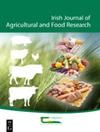Fortification of milk with phytosterol and its effect on sensory and physicochemical properties
IF 1.4
4区 农林科学
Q3 AGRICULTURE, MULTIDISCIPLINARY
引用次数: 7
Abstract
Abstract Phytosterols are a group of lipophilic steroid alcohols found in plants, which have been shown to lower cholesterol when supplemented in the diet. A commercial phytosterol preparation was added to milk in the form of an oil-in-water emulsion. For the preparation of an emulsion, diacetyl tartaric acid ester of mono- and diglycerides was used as an emulsifier and butteroil was used as a source of fat. Three emulsion formulations, i.e. A (8% phytosterols), B (10% phytosterols) and C (12% phytosterols), were prepared in which the levels of emulsifier (6.5%) and butteroil (10%) were kept constant, and each emulsion was added to milk at a rate of 5% (w/w). Based on sensory evaluation, B-emulsion formulation was selected for fortification of milk. The phytosterol content of the fortified milk determined by reverse-phase high-performance liquid chromatography was 410.8 mg/100 g. No significant loss in the initial content of phytosterol was observed after 1 week of storage. Sensory and physicochemical analyses indicated that significant differences were not observed between control and fortified milk samples up to 7 days of refrigerated storage. The present study suggests that it is feasible to add phytosterol as a functional ingredient in milk in the form of water-soluble emulsion to enhance health benefits of consumers. Two servings of such fortified milk per day provide almost the entire recommended daily requirement of phytosterol.用植物甾醇强化牛奶及其对感官和理化性质的影响
摘要植物甾醇是一组在植物中发现的亲脂性类固醇醇,当在饮食中补充时,它可以降低胆固醇。将商业植物甾醇制剂以水包油乳液的形式添加到牛奶中。为了制备乳液,使用甘油单酯和甘油二酯的二乙酰酒石酸酯作为乳化剂,使用牛油作为脂肪来源。制备了三种乳液配方,即A(8%植物甾醇)、B(10%植物甾醇)和C(12%植物甾醇),其中乳化剂(6.5%)和牛油油(10%)的含量保持恒定,并以5%(w/w)的速率将每种乳液添加到牛奶中。在感官评价的基础上,选择B型乳液配方对牛奶进行强化。通过反相高效液相色谱法测定强化乳的植物甾醇含量为410.8mg/100g。储存1周后,未观察到植物甾醇初始含量的显著损失。感官和物理化学分析表明,在冷藏7天之前,对照和强化牛奶样品之间没有观察到显著差异。本研究表明,以水溶性乳液的形式在牛奶中添加植物甾醇作为功能成分,提高消费者的健康益处是可行的。每天两份这样的强化牛奶几乎提供了建议的每日植物甾醇的全部需求。
本文章由计算机程序翻译,如有差异,请以英文原文为准。
求助全文
约1分钟内获得全文
求助全文
来源期刊
CiteScore
2.50
自引率
20.00%
发文量
23
审稿时长
>36 weeks
期刊介绍:
The Irish Journal of Agricultural and Food Research is a peer reviewed open access scientific journal published by Teagasc (Agriculture and Food Development Authority, Ireland). Manuscripts on any aspect of research of direct relevance to Irish agriculture and food production, including plant and animal sciences, food science, agri environmental science, soils, engineering, buildings, economics and sociology, will be considered for publication. The work must demonstrate novelty and relevance to the field of research. Papers published or offered for publication elsewhere will not be considered, but the publication of an abstract does not preclude the publication of the full paper in this journal.

 求助内容:
求助内容: 应助结果提醒方式:
应助结果提醒方式:


